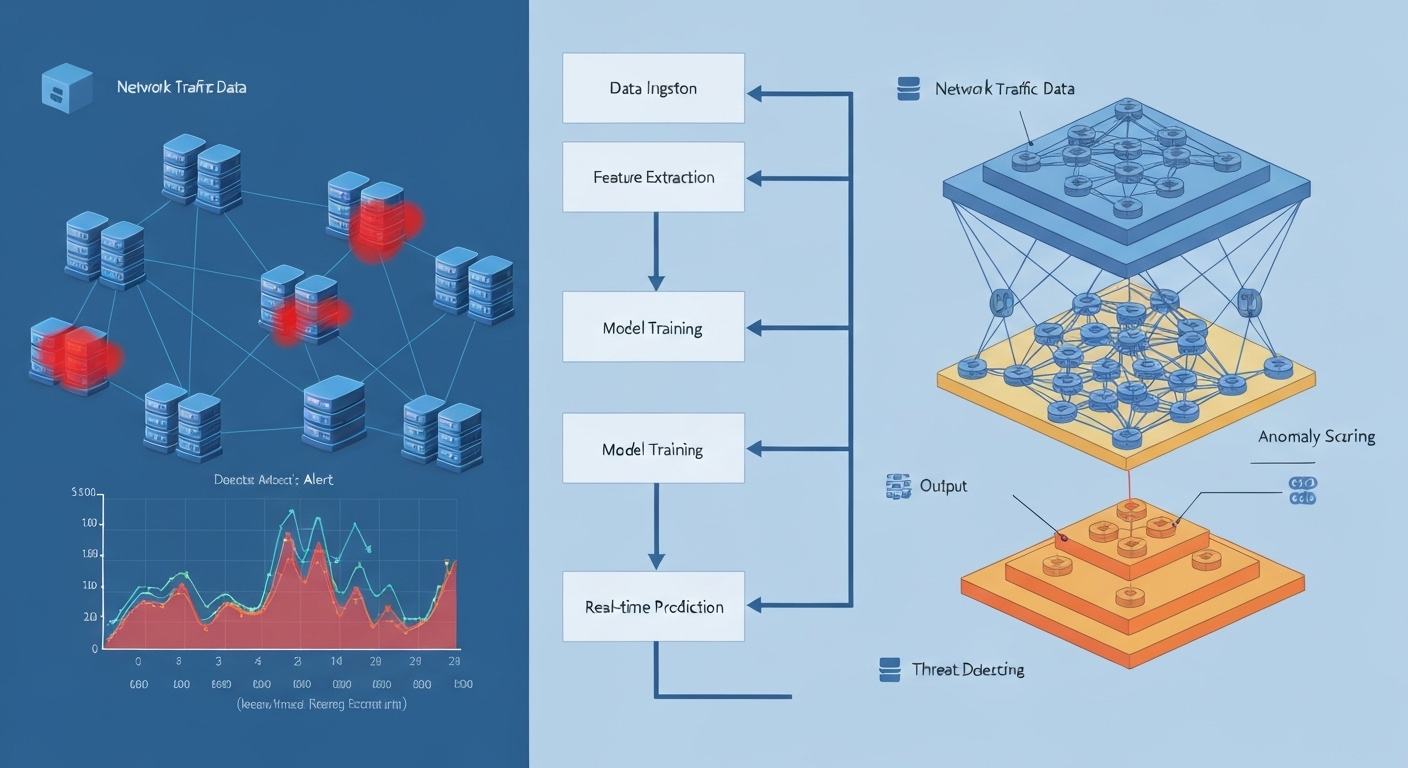Machine Learning for Network Security Monitoring : A Comprehensive Guide
Machine learning for network security monitoring is revolutionizing how organizations protect themselves from cyber threats. By leveraging the power of algorithms and data analysis, machine learning can automate threat detection, improve incident response times, and enhance overall security posture.

Understanding Machine Learning in Network Security
Traditional network security approaches often rely on signature-based detection and rule-based systems. While these methods are effective against known threats, they struggle to identify new and evolving attack patterns. Machine learning offers a more dynamic and adaptive approach by learning from network data and identifying anomalies that may indicate malicious activity. This helps overcome the limitations of traditional security measures by incorporating behavioral analysis techniques.

Key Benefits of Machine Learning for Network Security
- Enhanced Threat Detection: Machine learning algorithms can detect subtle anomalies and suspicious patterns that might be missed by traditional security systems.
- Improved Incident Response: By automating threat detection, machine learning can reduce the time it takes to respond to security incidents.
- Reduced False Positives: Machine learning can learn to distinguish between legitimate network activity and malicious behavior, reducing the number of false positive alerts.
- Automated Security Tasks: Machine learning can automate tasks such as vulnerability scanning, log analysis, and threat hunting, freeing up security professionals to focus on more strategic initiatives.
- Adaptability: Machine learning models can adapt to changing network environments and evolving threat landscapes, ensuring that security measures remain effective over time.
Machine Learning Algorithms for Cybersecurity
Several machine learning algorithms are commonly used in network security monitoring, each with its own strengths and weaknesses. Some of the most popular algorithms include:
- Supervised Learning: Algorithms like support vector machines (SVMs) and decision trees can be trained on labeled data to identify known threats.
- Unsupervised Learning: Algorithms like clustering and anomaly detection can identify unusual patterns in network data without requiring labeled data.
- Reinforcement Learning: Algorithms can learn to optimize security policies and configurations by interacting with the network environment.
- Deep Learning: Algorithms like recurrent neural networks (RNNs) and convolutional neural networks (CNNs) can analyze large amounts of network data to identify complex threat patterns. Deep learning for cybersecurity is becoming increasingly important as threats become more sophisticated.
Applying Machine Learning to Network Anomaly Detection
Network anomaly detection is a critical application of machine learning in network security. By learning the normal behavior of a network, machine learning algorithms can identify deviations from this baseline that may indicate malicious activity. This can include unusual traffic patterns, unauthorized access attempts, or malware infections. The use of advanced data analysis techniques is crucial for accurately detecting anomalies and minimizing false positives.

Integrating Machine Learning with Security Information and Event Management (SIEM)
Integrating machine learning with SIEM systems can significantly enhance threat detection and incident response capabilities. By feeding network data into a SIEM platform, machine learning algorithms can analyze logs, events, and alerts to identify potential security incidents. This allows security professionals to gain a more comprehensive view of the threat landscape and respond to incidents more quickly.
The integration of machine learning helps to improve the efficiency of security information and event management (SIEM) systems by automating the analysis of large volumes of data. This enables security teams to focus on investigating and responding to the most critical threats, rather than sifting through countless alerts.
Enhancing Threat Intelligence with Machine Learning
Threat intelligence feeds provide valuable information about known threats and vulnerabilities. Machine learning can be used to analyze threat intelligence data and identify patterns and trends that can help organizations proactively defend against attacks. For example, machine learning can be used to identify emerging malware variants, predict future attack vectors, and prioritize security patches.
Challenges and Considerations
While machine learning offers significant benefits for network security monitoring, there are also some challenges and considerations to keep in mind:
- Data Quality: Machine learning algorithms require high-quality data to perform effectively. Inaccurate or incomplete data can lead to poor performance and false positives.
- Model Training: Training machine learning models requires significant computational resources and expertise.
- Explainability: Some machine learning algorithms, such as deep learning models, can be difficult to interpret, making it challenging to understand why they made a particular decision.
- Adversarial Attacks: Machine learning models can be vulnerable to adversarial attacks, where attackers deliberately craft inputs to fool the model.
- Privacy Concerns: Collecting and analyzing network data can raise privacy concerns, particularly if the data contains sensitive information.

Best Practices for Implementing Machine Learning in Network Security
To successfully implement machine learning in network security monitoring, organizations should follow these best practices:
- Define Clear Objectives: Identify the specific security challenges that machine learning can help address.
- Gather High-Quality Data: Ensure that the data used to train machine learning models is accurate, complete, and relevant.
- Choose the Right Algorithms: Select machine learning algorithms that are appropriate for the specific security challenges.
- Monitor Model Performance: Continuously monitor the performance of machine learning models and retrain them as needed.
- Address Explainability: Use explainable AI techniques to understand why machine learning models made a particular decision.
- Protect Against Adversarial Attacks: Implement security measures to protect machine learning models from adversarial attacks.
- Address Privacy Concerns: Implement appropriate data privacy measures to protect sensitive information.
The Future of Machine Learning in Cybersecurity
Machine learning for network security monitoring is constantly evolving, with new algorithms and techniques being developed all the time. In the future, we can expect to see even more sophisticated applications of machine learning in cybersecurity, including:
- Automated Threat Hunting: Machine learning will be used to automatically identify and investigate potential security threats.
- Adaptive Security Policies: Machine learning will be used to dynamically adjust security policies based on changing threat conditions.
- Proactive Threat Prevention: Machine learning will be used to proactively prevent attacks before they occur.
- Improved Collaboration: Machine learning will be used to improve collaboration between security teams and share threat intelligence more effectively.
For more information on cybersecurity best practices, visit cisa.gov.
Learn more about our advanced security solutions at flashs.cloud.
Conclusion
Machine learning is a powerful tool for enhancing network security monitoring. By automating threat detection, improving incident response, and reducing false positives, machine learning can help organizations protect themselves from increasingly sophisticated cyber threats. While there are some challenges and considerations to keep in mind, the benefits of machine learning for network security are undeniable. As the threat landscape continues to evolve, machine learning will play an increasingly important role in keeping networks secure.
HOTLINE
+84372 005 899


